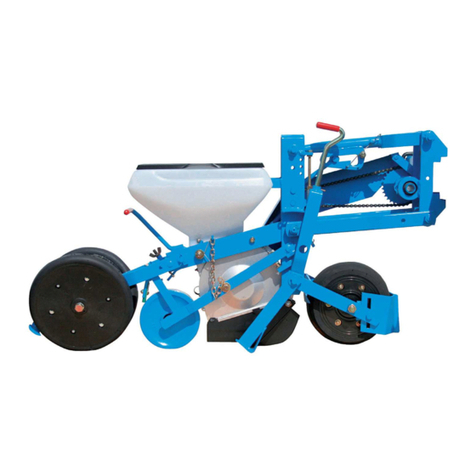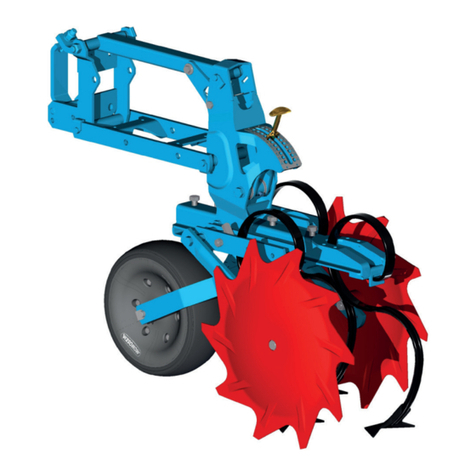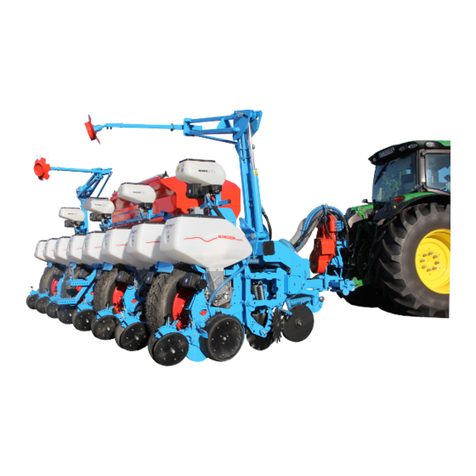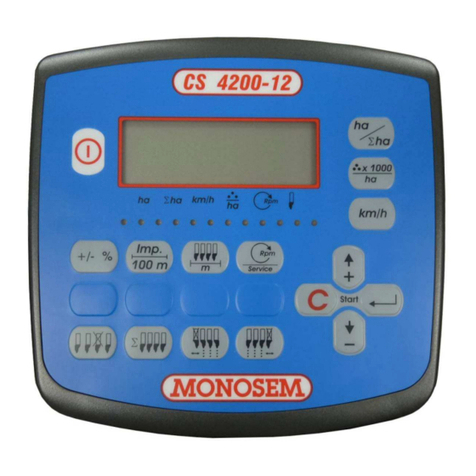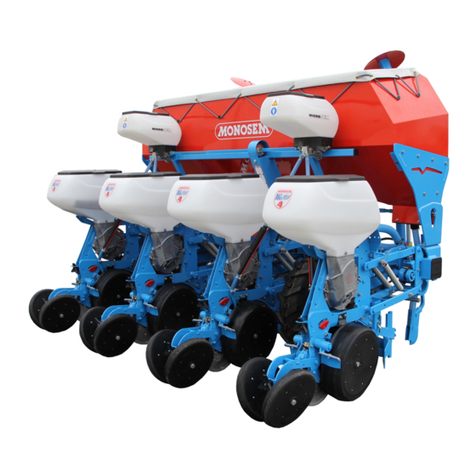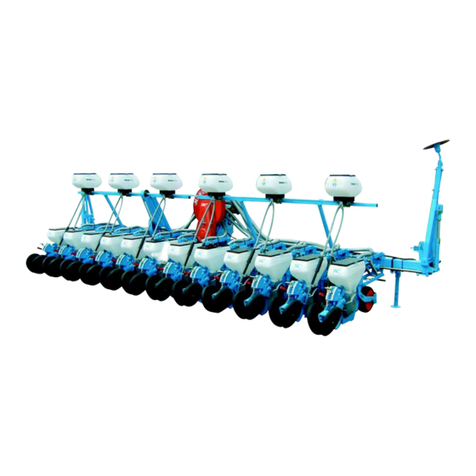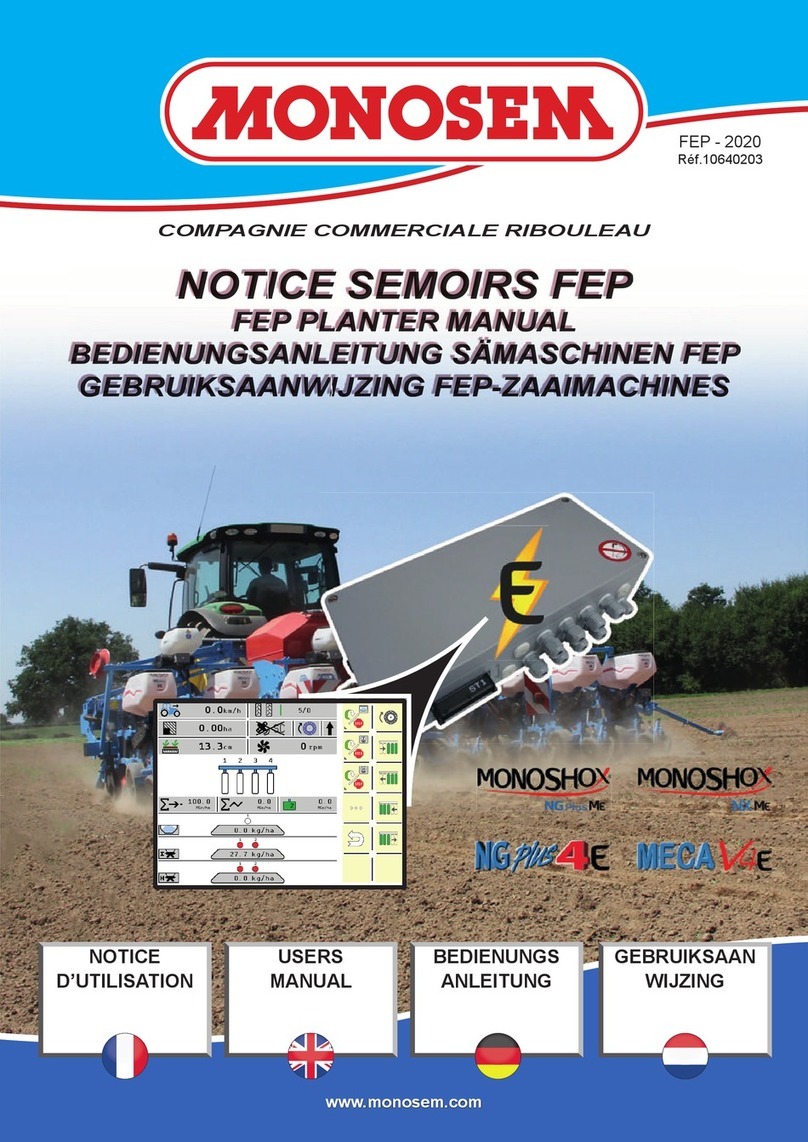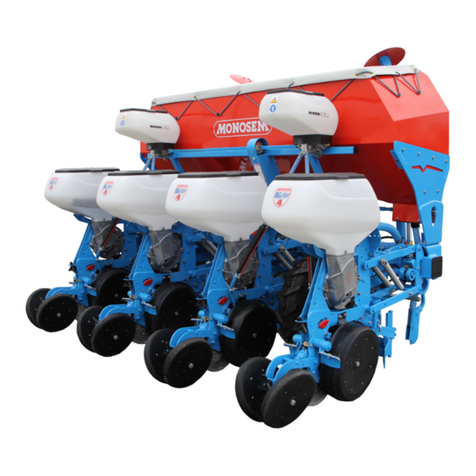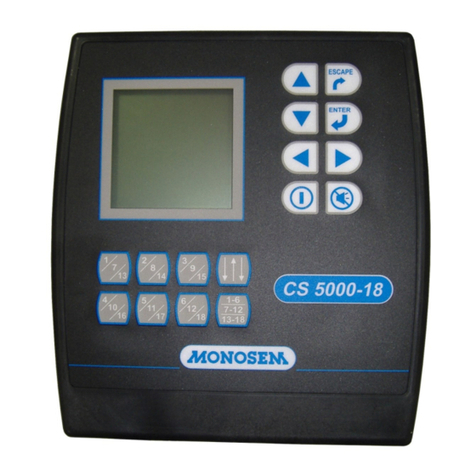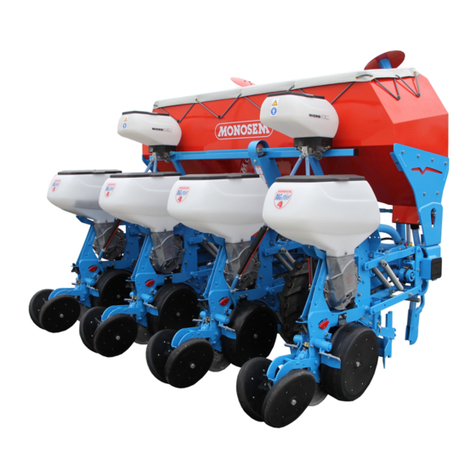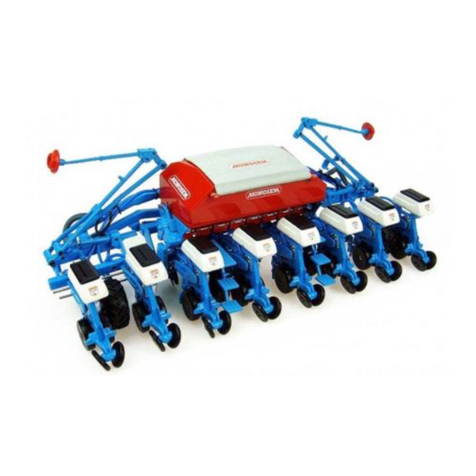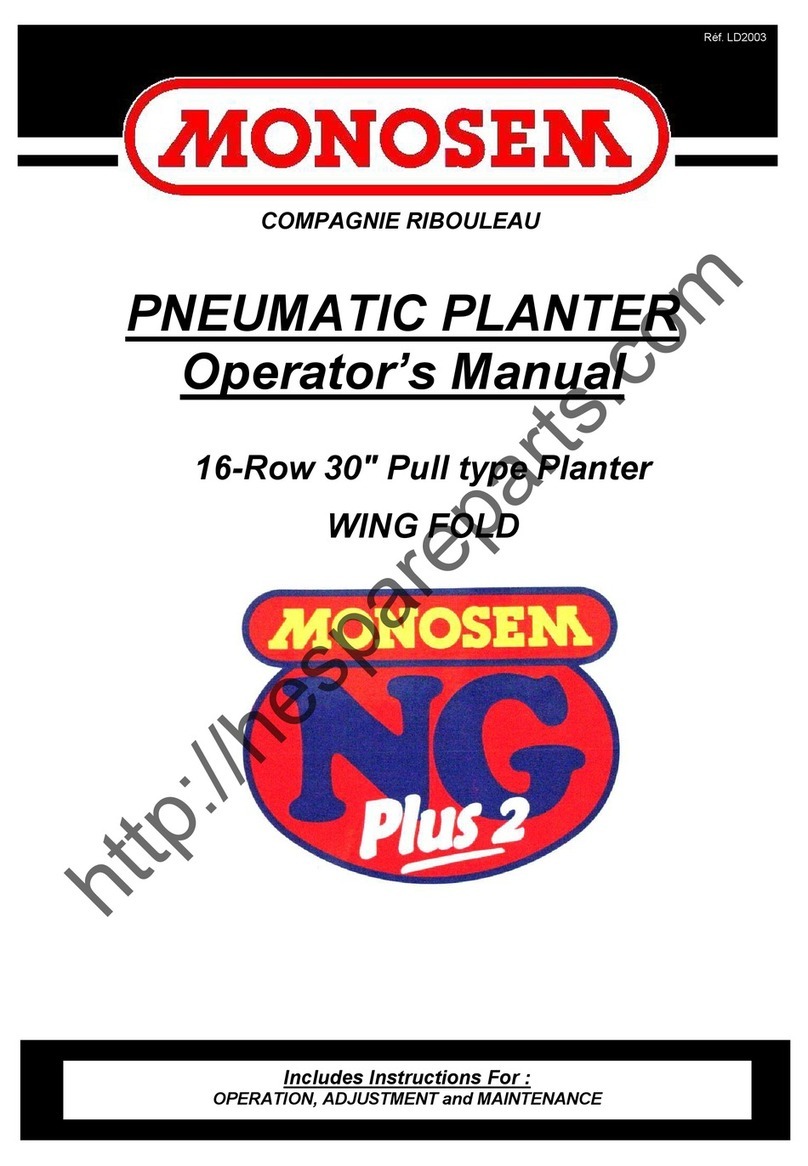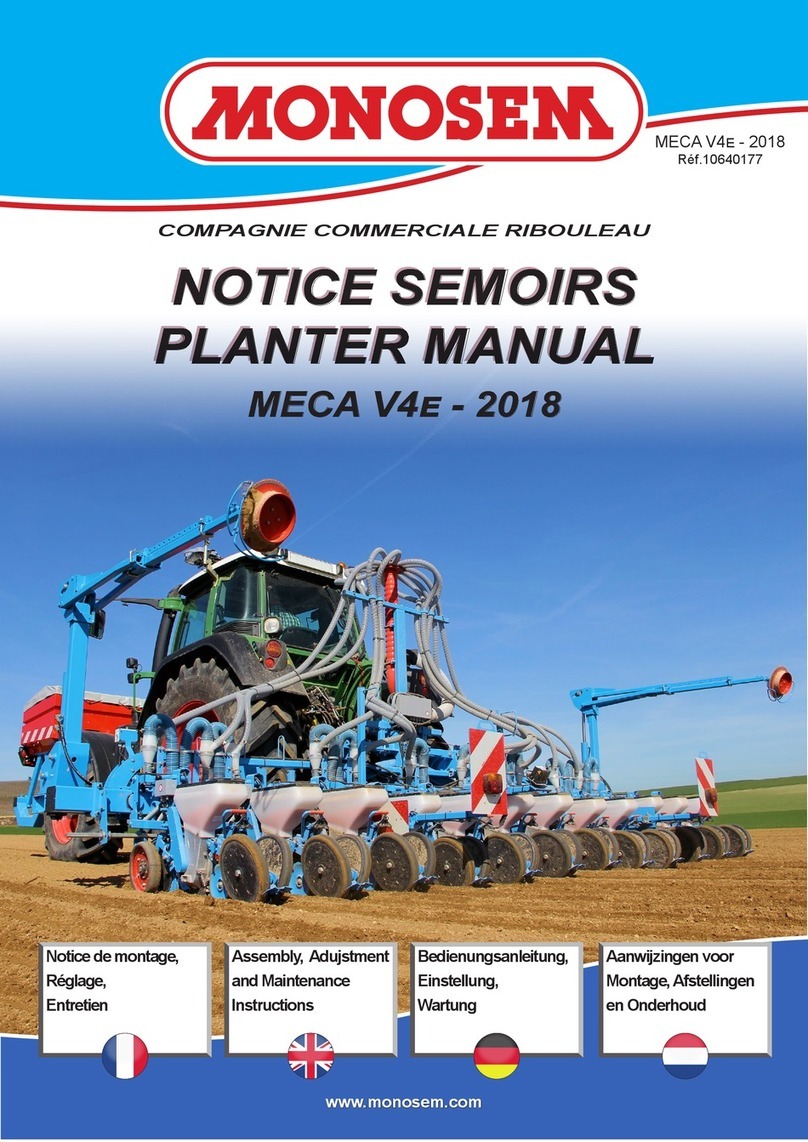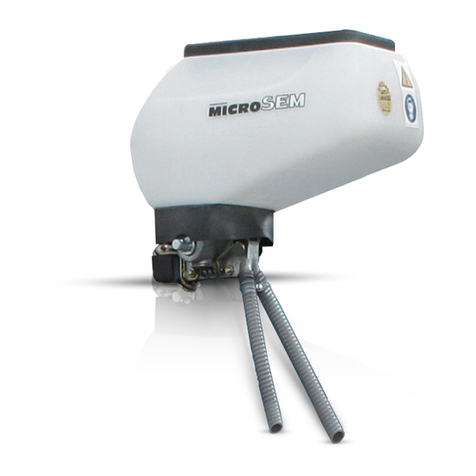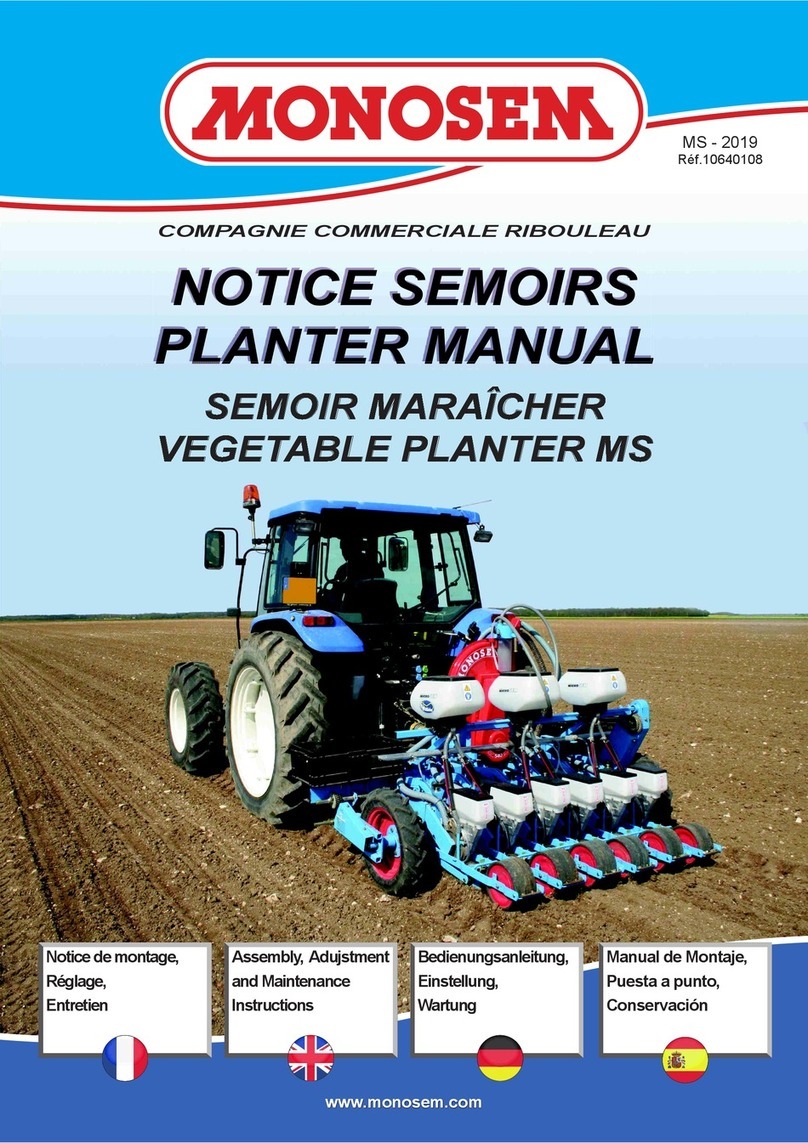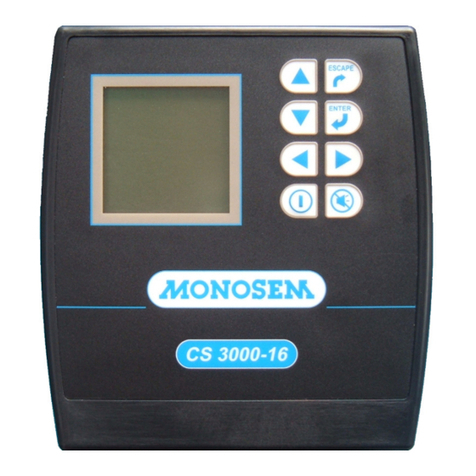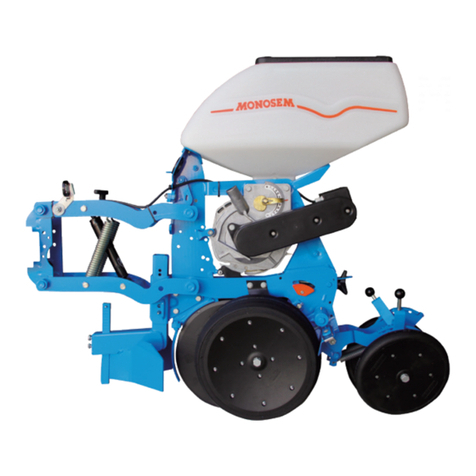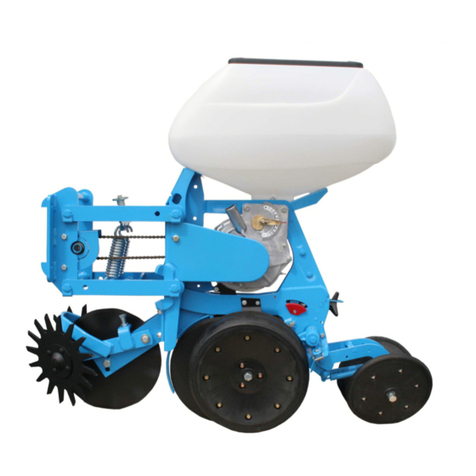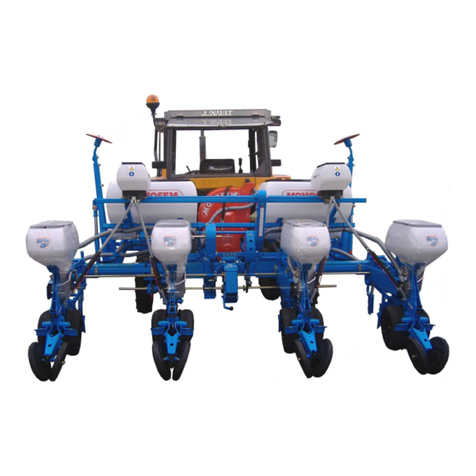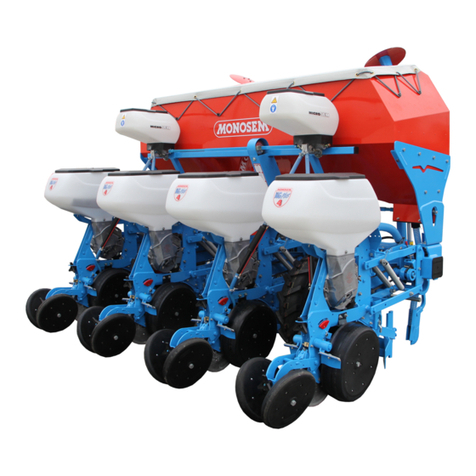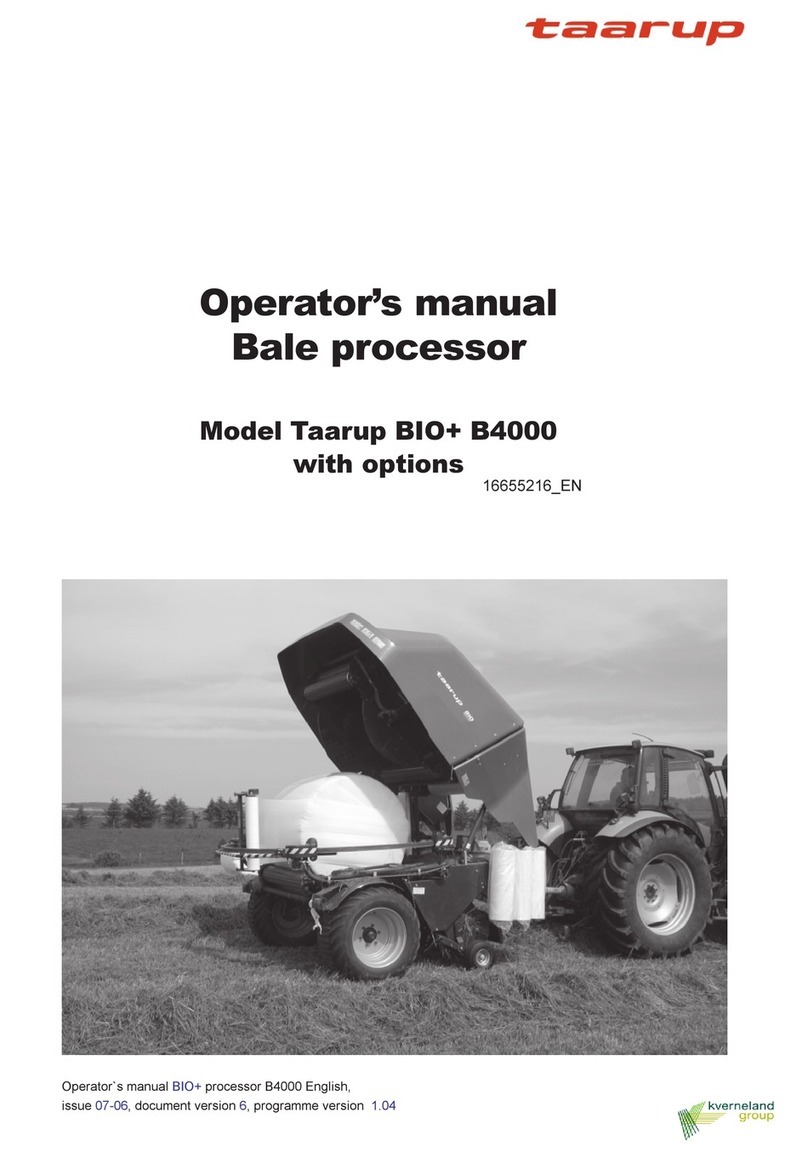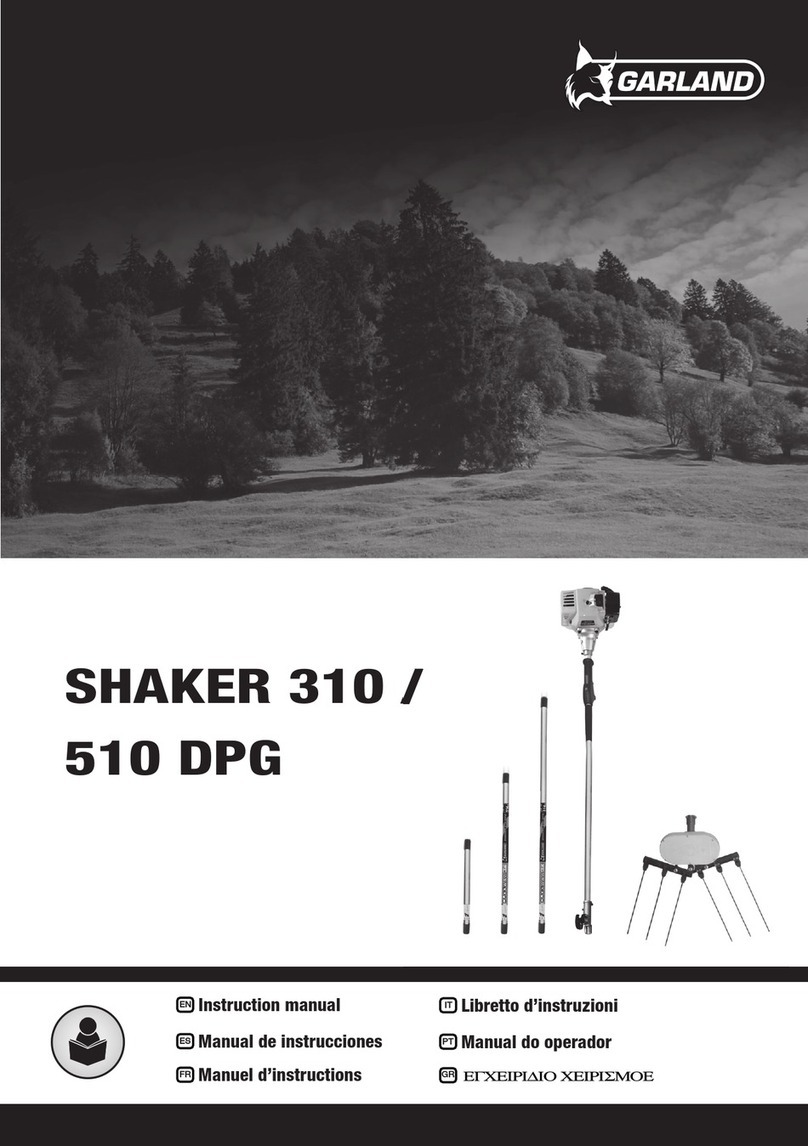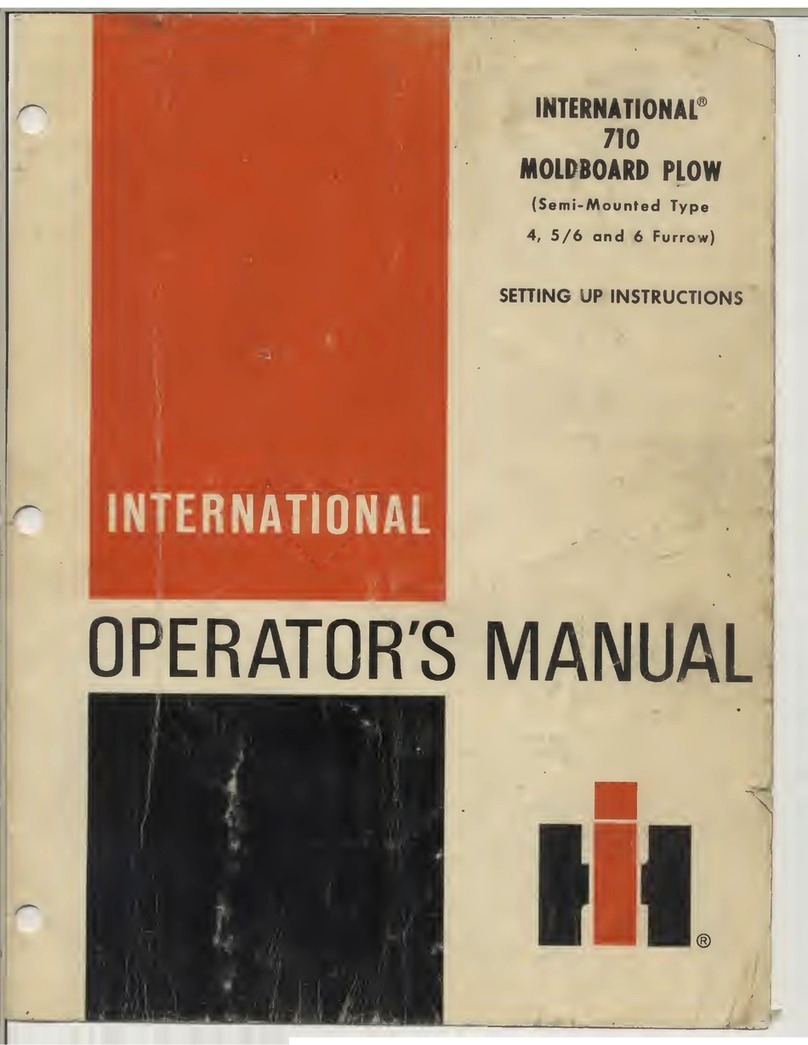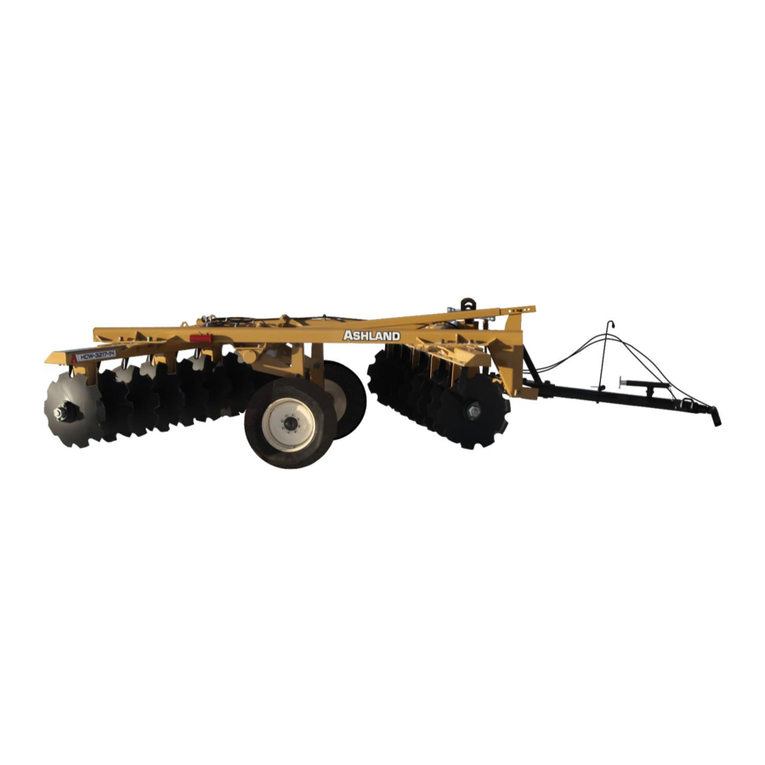
1
7
BESTIMMUNGSGEMÄSSE VERWENDUNG DER MASCHINE
Die Maschine darf nur für die Arbeiten eingesetzt werden, für die sie geplant ist.
Bei Beschädigung der Maschine infolge einer nicht vom Hersteller spezizierten Benutzung ist dieser nicht haftbar.
Jede nicht der ursprünglichen Bestimmung der Maschine entsprechende Benutzung erfolgt auf Rechnung und Gefahr des Benutzers
Die Bestimmungsgemäße Verwendung der Maschine setzt ebenfalls voraus :
- die Einhaltung der vom Hersteller verordneten Benutzungs-, Wartungs- und Instandsetzungsvorschriften,
- die ausschließliche Verwendung von Originalersatzteilen, Originalausrüstungen und Originalzubehör oder von Teilen, die vom Hersteller empfohlen sind.
- Die Drillmaschine darf nur von kompetenten, mit den technischen Daten und Benutzungsanweisungen der Maschine vertrauten Personen benutzt,
gewartet und repariert werden, die über die Risiken informiert sind, denen sie ausgesetzt sein könnten.
Streng die gültige Reglementierung einhalten bezüglich :
- der Unfallverhütung,
- der Arbeitssicherheit (Arbeitsgesetzbuch)
- des Strassenverkehrs (Strassenverkehrsordnung)
Die auf der Maschine angebrachten Warnungen berücksichtigen.
Der Hersteller haftet nicht für Schäden, die durch Abänderungen entstehen, die vom Benutzer selbst oder von Dritten ohne schriftliche Genehmigung an der
Maschine vorgenommen wurden.
ANHÄNGUNG
1 - Beim An- und Abkuppeln der Maschine am Schlepper, den Steuerhebel des Hydraulikkrafthebers so stellen, dass der Hubvorgang nicht unerwartet ausgelöst
werden kann.
2 - Beim Anhängen der Maschine am Dreipunktkraftheber des Schleppers darauf achten, dass die spindel- oder Zapfendurchmesser dem Durchmesser der
Schlepperkugelgelenke entsprechen.
3 - Vorsicht ! Im dreipunkt-Hubbereich bestehen Stauch- und Abscherrisiken!
4 - Sich bei Betätigung des äußeren Krafthebersteuerhebels nicht zwischen Schlepper und Maschine aufhalten..
5 - Beim Transport muss die Maschine durch die Versteifungsstreben des Krafthebers zur Vermeidung von Unwucht und seitlicher Pendelung stabilisiert werden.
6 - Beim Transport der Maschine in angehobener Stellung den Kraftheber-Steuerhebel blockieren.
ANTRIEBSORGANE (Zapfwelle und Gelenkwellen-Antrieb)
1 - Nur die mit der Maschine gelieferte oder vom Konstrukteur empfohlene Gelenkwelle verwenden.
2 - Die Schutzvorrichtungen der Zapfwellen und Gelenkwellen müssen immer angebracht und in gutem Zustand sein.
3 - Auf die richtige Überlappung der Gelenkwellenrohre sowohl in Arbeits- als auch in Transportstellung achten.
4 - Vor Anschließen oder Abziehen einer Gelenkwelle die Zapfwelle auskuppeln, den Motor abschalten und den Zündschlüssel abziehen.
5 - Ist die Primärkardanwelle mit einem Drehmomentbegrenzer oder einer Freilaufkupplung ausgestattet, müssen diese unbedingt auf der Zapfwelle der Maschine
montiert sein.
6 - Immer auf die korrekte Montage und Verriegelung der Kardanantriebe achten.
7 - Immer darauf achten, dass die Schutzvorrichtungen der Gelenkwellen mit den dafür vorgesehenen Ketten gegen Verdrehen gesichert sind.
8 - Vor Kuppeln der Zapfwelle prüfen, ob die gewählte Drehzahl und die Drehrichtung der Zapfwelle den Vorschriften des Herstellers entsprechen.
9 - Vor Kuppeln der Zapfwelle kontrollieren, ob sich keine Personen oder Tiere in Nähe der Maschine benden.
10 - Die Zapfwelle auskuppeln, wenn Gefahr besteht, dass die vom Hersteller vorgeschriebenen Grenzen des Gelenkwellenwinkels Überschritten werden.
11 - Vorsicht! Nach Auskuppeln der Zapfwelle können Teile der Maschine noch einige Zeit nachlaufen. Sich ihnen nie vor völligem stillstand nähern.
12 - Bei Abbau der Maschine die Gelenkwellen auf dem dafür vorgesehenen Haltern ablegen.
13 - Nach Abziehen der Gelenkwelle von der Schlepperzapfwelle muss diese mit ihrer Schutzkappe bedeckt werden.
14 - Schadhafte Schutzvorrichtungen der Zapfwelle und der Gelenkwelle müssen sofort ausgewechselt werden.
HYDRAULIKLEITUNG
1 - Vorsicht! Die Hydraulikleitung steht unter druck.
2 - Bei Montage von Zylindern oder Hydraulikmotoren auf den korrekten Anschluss gemäß Anweisungen des Herstellers achten.
3 - Vor Anschluss eines Schlauches an der Hydraulikleitung des Schleppers dafür sorgen, dass die Schlepper- und maschinenseitigen Leitungen nicht unter Druck
stehen.
4 - Dem Benutzer der Maschine wird zur Vermeidung falscher Anschlüsse dringend geraten, die Kennzeichnungen auf den Hydraulikanschlüssen zwischen
Schlepper und Maschine zu beachten, da sonst die Gefahr einer Funktionsumkehrung besteht (z.B. : Heben/Senken).
5 - Einmal im Jahr dir Hydraulikschläuche kontrollieren auf :
- Beschädigung der Aussenschicht
- Porosität der Aussenschicht
- Verformung ohne Druck und unter Druck
- Zustand der Verbindungen und Dichtungen .
Die maximale Benutzungsdauer der Schläuche ist 6 Jahre. Beim Auswechseln darauf achten, dass nur Schläuche verwendet werden, deren Eigenschaften
und Qualität den Vorschriften des Maschinenkonstrukteurs entsprechen.
6 - Bei Feststellung einer undichten Stelle alle Vorsichtsmassnahmen zur Unfallverhütung treen
7 - Eine unter Druck stehende Flüssigkeit, insbesondere das öl der Hydraulikleitung, kann die Haut durchbringen und schwere Verletzungen verursachen! Bei
Verletzungen sofort Arzt konsultieren; Infektionsgefahr !
8 - Vor jedem Eingri in die Hydraulikanlage Maschine ablassen, Anlage drucklos schalten, Motor abstellen und Zündschlüssel abziehen.
WARTUNG
1 - Vor Instandsetzungs-, wartungs- oder Reparaturarbeiten sowie bei Ermitteln einer Pannen- oder Betriebsstörungsquelle muss die Zapfwelle ausgekuppelt, der
Motor abgeschaltet und der Zündschlüssel abgezogen sein.
2 - Regelmäßig kontrollieren, ob Schrauben und Muttern fest angezogen sind. Notfalls anziehen. Nach den ersten Betriebsstunden (4 Stunden) müssen alle
Schrauben nachgezogen werden. Danach diesen Eingri alle 80 Stunden wiederholen.
3 - Vor Wartung einer Maschine in angehobener Stellung diese mit einem geeigneten Mittel abstützen.
4 - Beim Austausch eines Funktionsteiles (Schaufel bei Streuern oder schare bei Drillmaschinen) Schutzhandschuhe tragen und nur geeignete Werkzeuge
benutzen.
5 - Zum Schutz der Umwelt ist es verboten, Öl, Fett und Filter jeder Artwegzuwerfen oder auszugießen. Sie sind von darauf spezialisierten Unternehmen zu
entsorgen.
6 - Vor Eingri an de elektrischen Leitung die Stromzufuhr unterbrechen.
7 - Verschleiß ausgesetzte Schutzvorrichtungen müssen regelmäßig kontrolliert werden. Sie sofort austauschen, wenn Schadhaft.
8 - Ersatzteile müssen den vom Konstrukteur festgelegten Normen und Kennkennwerten entsprechen. Nur Ribouleau – Monosem Ersatzteile verwenden !
9 - Vor Elektroschweissarbeiten am Schlepper oder der angehängten Maschine die Kabel des Wechselstromgenerators und der Batterie abziehen.
10 - Reparaturen an Organen, die unter Spannung oder Druck stehen (Federn, Druckspeicher, usw…)setzen eine ausreichende Qualikation voraus und erfordern
Werkzeuge; sie dürfen daher nur von qualiziertem Personal durchgeführt werden.
